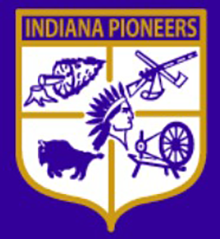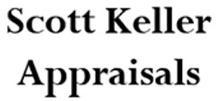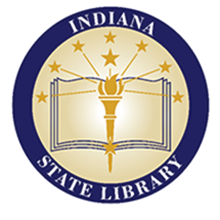Airs Saturdays, noon to 1 p.m. ET on WICR 88.7 FM.
Or stream audio live from anywhere on WICR Online!
March 26, 2022
Block’s, Wasson’s and Strauss: bygone major retailers in Indy
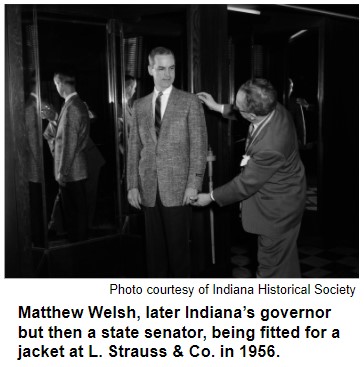 This show will follow up previous Hoosier History Live programs in two ways. We showcased the founding and evolution of the legendary Indianapolis-based department store L.S. Ayres & Co. during a show in 2013. And just last week, we focused on Jewish immigration to Indiana from 1840 through the 1920s.
This show will follow up previous Hoosier History Live programs in two ways. We showcased the founding and evolution of the legendary Indianapolis-based department store L.S. Ayres & Co. during a show in 2013. And just last week, we focused on Jewish immigration to Indiana from 1840 through the 1920s.
Our follow-up show will spotlight the two department stores that rivaled Ayres for about 100 years: William H. Block Co. and H.P. Wasson & Co., known conversationally by generations of Hoosier shoppers as “Block’s” and “Wasson’s”. In addition, we will explore L. Strauss & Co., which also was based in downtown Indy and specialized in high-quality clothing. Jewish merchants founded or built all three retailers in the late 1800s, with multiple generations of Jewish families overseeing the businesses for much of the 1900s. (The Ayres family was Protestant.)
Nelson’s guest will be Ken Turchi, the author of the new book Looking Forward, Giving Back: The Jewish Merchants of Downtown Indianapolis (Indiana Historical Society Press), which describes the history of Block’s, Wasson’s, Strauss and other retailers. Ken also was the guest on our Ayres show because his previous books include L.S. Ayres & Co., The Store at the Crossroads of America (IHS Press).

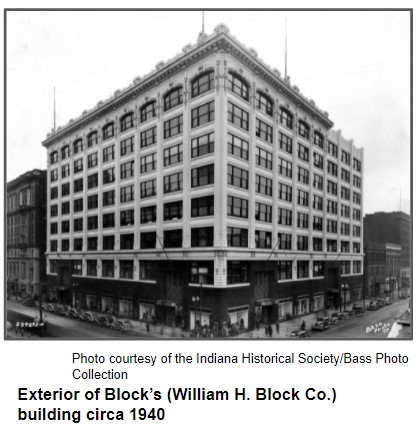 The former assistant dean at the Indiana University Maurer School of Law, Ken recently semi-retired and now lives in Charleston, S.C. Referring to the founders of Block’s, Wasson’s and other stores, he writes:
The former assistant dean at the Indiana University Maurer School of Law, Ken recently semi-retired and now lives in Charleston, S.C. Referring to the founders of Block’s, Wasson’s and other stores, he writes:
“Many of them started out as peddlers, selling pots and pans in the Jewish neighborhoods of Indianapolis. By 1900, these enterprising peddlers had opened storefronts along Washington Street, and their businesses grew with the city.”
And they didn’t just grow within Indy. Ayres, Block’s and Wasson’s, the “Big Three” flagship department stores downtown, eventually became chains with outlets in Greenwood, Anderson, Bloomington and other cities; many also had stores in suburban Indy shopping centers such as Glendale, Eastgate and Castleton Square.
The eight-story building that housed the flagship Block’s department store remains part of downtown Indy’s skyline, having been converted into apartments. The store opened in 1911 and was overseen by William H. Block (1855-1928), a Hungarian immigrant who had studied to be a rabbi in his homeland.
 Although Ken writes that Ayres became “the city’s finest and best-loved department store throughout its long history”, he notes that Block’s topped its rival in some areas, including men’s clothing. (With its slogan “That Ayres Look”, Ayres focused on women’s fashions.) Generations of bankers, lawyers and physicians often chose, though, to shop at the Strauss store. Its history, as described in Ken’s book, dates to the 1850s and a store founded by two Jewish merchants that initially was known as the Eagle Clothing Company. Leopold Strauss (1842-1914) began there as a clerk and worked his way up, eventually owning and renaming the store, which, as Ken writes, specialized in “high-quality, high-cost clothing, shoes and accessories.”
Although Ken writes that Ayres became “the city’s finest and best-loved department store throughout its long history”, he notes that Block’s topped its rival in some areas, including men’s clothing. (With its slogan “That Ayres Look”, Ayres focused on women’s fashions.) Generations of bankers, lawyers and physicians often chose, though, to shop at the Strauss store. Its history, as described in Ken’s book, dates to the 1850s and a store founded by two Jewish merchants that initially was known as the Eagle Clothing Company. Leopold Strauss (1842-1914) began there as a clerk and worked his way up, eventually owning and renaming the store, which, as Ken writes, specialized in “high-quality, high-cost clothing, shoes and accessories.”
Wasson’s, as Ken puts it, was known as “an everyman’s store . . . catering to middle class customers”. It carved out a reputation for selling kitchenware, appliances and clothing at lower prices than its competitors. The founder, Hiram P. Wasson, began working in the 1870s as an errand boy at a store known as the Bee Hive Dry Goods; he was so dedicated that he often slept on the store’s counters at night. After his death in 1910, generations of the Efroymson and Wolf families ran the store, which was the first of the “Big Three” to expand beyond downtown.
Some history facts:
In the 1850s, the first department store was founded in Paris, according to Ken Turchi’s book.
Block’s was one of the few department stores in the country with its own candy-making operation.
In 1958, Wasson’s became the first department store in the country to distribute home swimming pools.
Our guest Ken Turchi will make a presentation at the Indiana History Center on April 14 about the philanthropy of the families associated with Block’s, Wasson’s, Strauss and other retail stores. More information is available at https://indianahistory.org/events/from-retail-to-tzedakah/ There also is an exhibit at the History Center about the merchants featured in his book Looking Forward, Giving Back.
Roadtrip: Belmont Beach along the White River in Indy
 The west bank of the White River in Haughville, just south of 16th Street, used to be the only convenient place for Blacks to swim in that area of town. Prior to desegregation, most public pools in Indianapolis were for whites only.
The west bank of the White River in Haughville, just south of 16th Street, used to be the only convenient place for Blacks to swim in that area of town. Prior to desegregation, most public pools in Indianapolis were for whites only.
Guest Roadtripper Kisha Tandy, Curator of Social History at the Indiana State Museum, says that Belmont Beach first opened in 1936 as a segregated swimming spot. Years later, when public pools were finally desegregated, Belmont Beach returned to weeds and grass.
The new Belmont Beach pop-up park opened in 2021 with plenty of “sweat equity” from Haughville residents. It features a sandy beach area, an art zone, walking paths, a basketball court, fishing, and more. No, you cannot actually swim in the river because it is too polluted. And one wonders if it was truly safe in the 1930s! But it does serve as a tribute to Indy’s heritage. Its official address is 1350 N White River Pkwy W Drive.
Hoosier History Looks Back - Our “Hellbender” show in November 2019
Ever hear of a hellbender? How about an orange-fringed orchid? Our “Rare plants and animals in Indiana” show aired on November 16, 2019 with guests herpetologist Nate Engbrecht of the Indiana Department of Natural Resources, and botanist Michael Homoya, retired from the DNR.
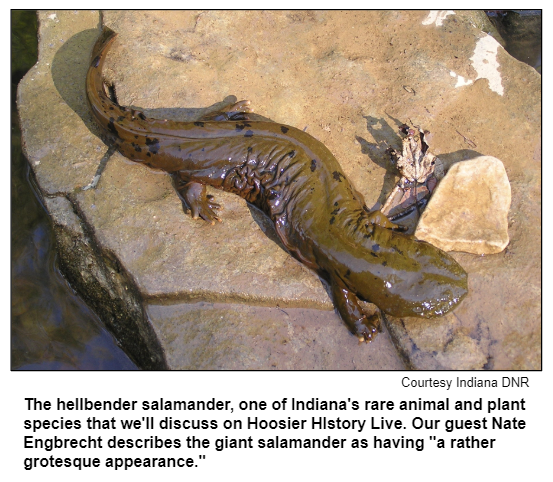
“Hellbinders in the Blue” is a recently released short (and fun!) documentary about restoring the Hellbinder population in southern Indiana’s Blue River, supported in partyby Indiana Humanities as part of their Water/Ways initiative. You can also listen to the Hoosier History Live show podcast here: https://hoosierhistorylive.org/audio/2019-11-16-Rare-plants-and-animals.mp3
Nelson Price, host and historian
Molly Head, producer/general manager, (317) 506-7164
Ryan DeRome, associate producer
Cheryl Lamb, administrative manager
Richard Sullivan, senior tech consultant
Pam Fraizer, graphic designer
Garry Chilluffo, consultant
Please tell our sponsors that you appreciate their support!

 Acknowledgments to WICR-FM, Fraizer Designs, The Indiana Album, Monomedia, Indiana Historical Bureau, Indiana Landmarks, Henri Pensis, Kielynn Talley, Genesis Brown, Heather McIntyre, and many other individuals and organizations. We are independently produced and are self-supporting through organizational sponsorship and through individual contribution at the yellow button on our newsletter or website. For organizational sponsorship, which includes logos, links, and voiced credits in the show, contact Molly Head at (317) 506-7164 or email her at molly@hoosierhistorylive.org. Our media reach continues to grow via podcasting.
Acknowledgments to WICR-FM, Fraizer Designs, The Indiana Album, Monomedia, Indiana Historical Bureau, Indiana Landmarks, Henri Pensis, Kielynn Talley, Genesis Brown, Heather McIntyre, and many other individuals and organizations. We are independently produced and are self-supporting through organizational sponsorship and through individual contribution at the yellow button on our newsletter or website. For organizational sponsorship, which includes logos, links, and voiced credits in the show, contact Molly Head at (317) 506-7164 or email her at molly@hoosierhistorylive.org. Our media reach continues to grow via podcasting.
Thank you!
We'd like to thank the following recent individual contributors who make this show possible. For a full list of contributors over the years, visit Support the Show on our website.
- Marion Wolen
- Dr. Charles Schisla
- Jane Simon Ammeson
- Serita Borgeas
- Jill Lough Chambers
- Barbara Stillwell
- Joseph B. Young III
- Yetta Wolen
- Dr. James Madison
- Dr. William McNiece
- Michael Freeland and Sharon Butsch Freeland
© 2022 Hoosier History Live. All rights reserved.
|

